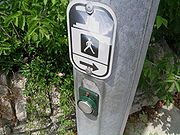
Walk button
Encyclopedia

Traffic light
Traffic lights, which may also be known as stoplights, traffic lamps, traffic signals, signal lights, robots or semaphore, are signalling devices positioned at road intersections, pedestrian crossings and other locations to control competing flows of traffic...
configurations, the purpose of which is to allow pedestrian
Pedestrian
A pedestrian is a person traveling on foot, whether walking or running. In some communities, those traveling using roller skates or skateboards are also considered to be pedestrians. In modern times, the term mostly refers to someone walking on a road or footpath, but this was not the case...
s to safely cross a designated portion
Pedestrian crossing
A pedestrian crossing or crosswalk is a designated point on a road at which some means are employed to assist pedestrians wishing to cross. They are designed to keep pedestrians together where they can be seen by motorists, and where they can cross most safely across the flow of vehicular traffic...
of a road. They were first introduced in various forms during the 1960s as part of a general push to improve pedestrian safety. Today they are ubiquitous in cities and urban areas across the industrialized world; although their functionally is sometimes disputed.
History
Due to growing frustrations over the ineffectiveness of the traditional Zebra crossingZebra crossing
A zebra crossing is a type of pedestrian crossing used in many places around the world. Its distinguishing feature is alternating dark and light stripes on the road surface, from which it derives its name. A zebra crossing typically gives extra rights of way to pedestrians.The use of zebra...
, the early 1960s saw the advent of a number of newly designed systems. The first among them was the Panda crossing
Panda crossing
The panda crossing was a type of signal-controlled pedestrian crossing used in the United Kingdom from 1962 to 1967.-Background:In the early 1960s, the British Ministry of Transport, headed by Ernest Marples, was looking for a way to make pedestrian crossings safer under increasingly heavy traffic...
, which made its debut in 1962. Despite its inclusion of a rudimentary intersection crossing button, the design’s unwieldy and overly complex system of lights assured its early retirement.
Though the Panda crossing proved a failure, the value of the signal-controlled pedestrian road crossing was nevertheless recognized. The walk button was thus included in a number of other ill-fated crosswalks released during the 60s (Pin Man, X-Way) before being made a standard feature of the Pelican crossing
Pelican crossing
A Pelican crossing is a type of pedestrian crossing featuring a pair of poles each with a standard set of traffic lights facing oncoming traffic, a push button and two illuminated, coloured men facing the pedestrian from across the road - a red, stationary man to indicate that it is not safe to...
, which was introduced in 1969.
With its refined and comprehensive light configuration, independent walk signals, and innovative incorporation of a fixed crossing time, the Pelican avoided all of the pitfalls of its predecessors while effectively addressing traffic congestion and pedestrian safety. As a result, the design quickly obtained immense popularity in both Britain
United Kingdom
The United Kingdom of Great Britain and Northern IrelandIn the United Kingdom and Dependencies, other languages have been officially recognised as legitimate autochthonous languages under the European Charter for Regional or Minority Languages...
and the United States
United States
The United States of America is a federal constitutional republic comprising fifty states and a federal district...
, effectively establishing the inclusion of the intersection crossing button in almost all future crosswalk designs.
Use
Intersection crossing buttons typically revolve around a very basic concept: pressing the button eventually forces all cars at said intersection to stop, triggering the walk signal on the opposite side of the road (green person means ‘walk’, red person means ‘don’t walk’). This allows pedestrians to navigate the crosswalk in safety. However, vast differences in the relative sizes of pedestrian populations necessitate the existence of several variations in the popular design.In the most well-known type, pressing the button when there is no nearby traffic will immediately trigger the walk signal. If there is traffic, it will either allow one to cross at the soonest opportunity or, if sooner, its regular time interval.
The second type, which is often hard to distinguish from the first, only allows crossings at its fixed time interval. Pressing the button typically causes either a time extension for crossing the road or the superficial difference of the words "WALK" or "GO" appearing in place of the green man.
The third, and most deceptive type, does absolutely nothing. It is known as a placebo button
Placebo button
A placebo button, also called an idiot button, is a push-button with apparent functionality that actually has no effect when pressed, analogous to a placebo. In other cases, a control like a thermostat may not be connected....
. Such buttons were typically functional at one point in time, and were only later disabled due to malfunction, maintenance, or other changes in the traffic configuration. For instance, in New York City
New York City
New York is the most populous city in the United States and the center of the New York Metropolitan Area, one of the most populous metropolitan areas in the world. New York exerts a significant impact upon global commerce, finance, media, art, fashion, research, technology, education, and...
, many were deactivated in the late 1980s to prevent interference with the new computer-coordinated signals, although the disconnected mechanisms were left attached to save removal costs.

